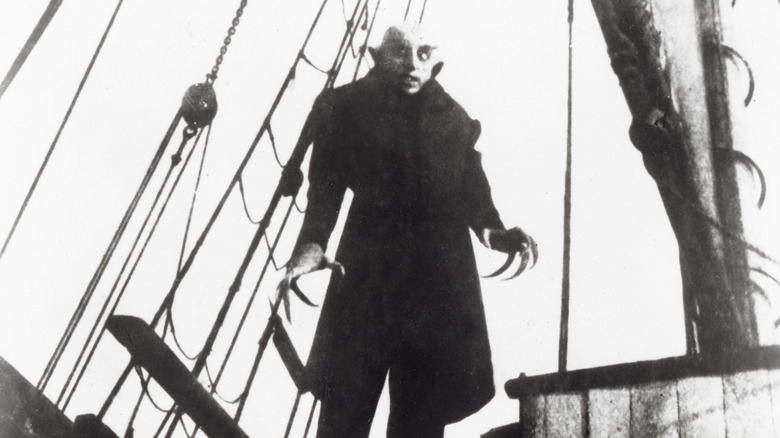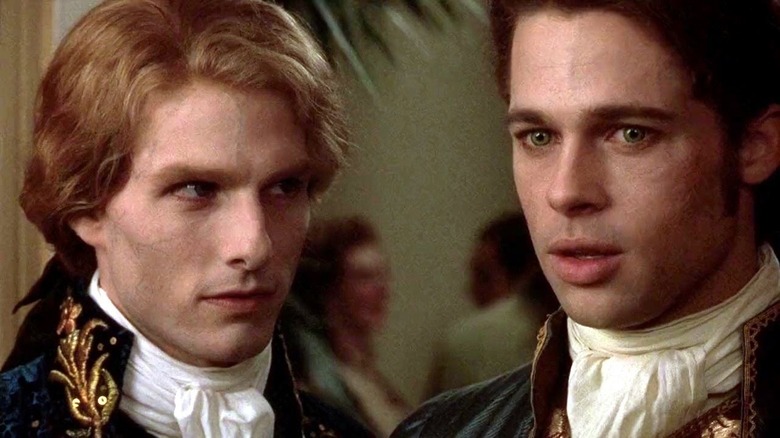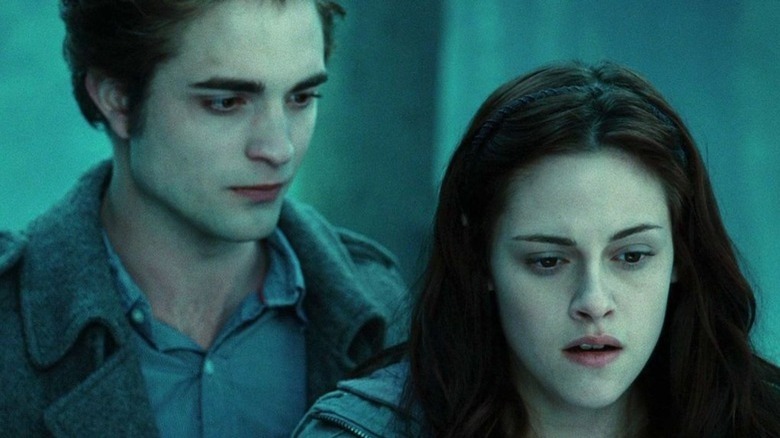Movie Vampire Mythology Explained
This content was paid for by Netflix and created by Looper.
Vampires have been a bloody good staple of cinema for more than a century, but throughout film history, Hollywood has given these creatures of the night a lot of different looks and, perhaps more importantly, some dramatically different mythological makeups. In the olden days, big-screen vampires could be pretty prototypical movie monsters, but now, they can be scary, attractive, or even downright hilarious, depending on the film at hand.
There are also a growing number of modern vamps who maintain an amazing amount of humanity beneath all the fangs and fury, and their stories are about so much more than just finding some fresh flesh to snack on. In "Blood Red Sky," we meet Nadja (Peri Baumeister), a single mother who's worked hard to keep her vampirism in check for the sake of her son, but she has to make the difficult decision whether to unleash the monster within once their plane is hijacked by terrorists who threaten to destroy everyone on board. Nadja's characteristics are quite unique in the film, but she's not the only bloodthirsty being to have a conscience on the silver screen.
Let's take a look at the evolution of movie vampires and how they've led up to this highly intelligent and even caring creature.
The birth of bloodsuckers
Like many fictitious monsters, the origin of vampires can be traced back centuries to a time when myth and medicine went hand in hand. In the 16th century, accounts of European villagers whose bodies didn't decompose in normal course and corpses that had "fresh" blood in their stomachs were some of the earliest known examples of vampirism being treated as a real-life disease. Also, a lack of understanding when it came to certain illnesses — like porphyria, which can cause an intense sensitivity to sunlight — may have contributed to the characteristics people associated with vampirism. Eventually, this theory made its way into the entertainment realm.
Though Bram Stoker wasn't the first author to pen stories about vampires, his classic 1897 novel "Dracula" certainly brought the creature into the mainstream for good. More than a century later, the titular monster is still a mainstay of entertainment, with dozens of movies giving new imagination to the character.
The 1922 silent horror film "Nosferatu," for example, was one of the earliest, albeit unauthorized, adaptations of "Dracula," and it became a pillar of vampire cinema. The film featured Max Schreck as Count Orlok, a mysterious nobleman whose very name struck fear into the heart of Transylvanian villagers. Orlok slept in coffins, sucked blood, and was eventually evaporated by sunlight.
Then, in 1931, there was "Dracula," starring Bela Lugosi in the title role. It was an official take on the classic novel and gave the vampire a bit more of a refined air, with improved societal status and a penchant for fashion. This version of Dracula also drank blood and slept in coffins, but he had no reflection in the mirror, could hypnotize others, and was susceptible to wolfsbane, sunlight, and stakes through the heart. Lugosi would go on to reprise the role for the 1948 comedy "Abbott and Costello Meet Frankenstein," which featured Dracula as one of several movie monsters.
Though Dracula has since been given several style changes in cinema, the visage of an isolated, aristocratic vampire who sleeps in coffins has remained influential to the subgenre, particularly in the so-called Hammer era of films, in which vampires (including Christopher Lee's take on Dracula) were purely villainous and devilish creatures. Meanwhile, hunters like Van Helsing and the would-be victims who fought back against their bloodthirsty attackers were the true heroes of these stories.
A new breed of biter
Vampires may have arisen in pop culture as ungodly creatures whose sole goal is to survive by feasting on blood and creating others of their ilk, but over the years, the characters were given a whole lot more nuance in films. For one thing, they became even more overt conduits for movie metaphors, like sexuality, addiction, and the rising fear of bloodborne pathogens. And in many cases, movie vampires also became a lot more human.
Even as certain tropes about movie vampires were left intact, like their sensitivity to religious relics and inability to come inside without permission, some modern vampire movies began to showcase some real personality behind each pair of fangs. For example, 1987's "The Lost Boys" featured Jason Patric as a teen who worked to stop his transition into a full-fledged vampire. And the 1994 adaptation of Anne Rice's "Interview with the Vampire" let its handsome bloodsucker Louis, portrayed by Brad Pitt, tell his own story of a centuries-long life as a reluctant and self-loathing member of the undead, who tried to subsist on the blood of rats and hated the impulse to kill or turn people. Louis even possessed the ability to cry and turned against members of his own kind by burning them.
Even in films where the action centered on vampire hunters — like the film "Buffy the Vampire Slayer," 1985's "Fright Night," and "Blade" — the creatures were far from one-dimensional. In fact, one of the most recent trends in vampire cinema is for the monsters to not only be sexually attractive in the eyes of humans but to also carry on meaningful relationships with people and try to survive without causing too much mayhem to mankind. Films like "Only Lovers Left Alive," for example, featured vampires who were reluctant to bite people, and in "Let the Right One In," while the main bloodsucker definitely had a craving for blood, the creature had a real connection with the movie's human protagonist. It's a nice twist on the vampire trope of the "familiar," a human servant who helps the monster survive.
Vampires aren't just undead monsters anymore
The "Twilight" saga went even further with the evolution of the vampire. Here, the entire Cullen coven bonded over their choice to become so-called "vegetarian" vampires, feasting only on animal blood. That series also diverged from its predecessors in the genre in some significant ways, including giving its vampires a very different reaction to the presence of sunlight — that is, their stony skin turned into sparkles instead of dust. Plus, the series had the color of their eyes indicate their diets, and the films gave many of the vampires superpowers that mirrored their previous talents and traits as human beings. The rise of vampires with the ability to love and restrain themselves was certainly a drastic departure from the rote creatures of old, but it also gave room for the undead monsters to really engage with society in some fascinating ways.
And "Blood Red Sky" offers a bit of both worlds because at first, Nadja is able to control her impulses with the help of medical injections, fully retaining her capacity for compassion and a protection instinct for her child and other humans. She even works to destroy others like her in order to prevent the spread of her species. Once she taps into her inner beast by drinking human blood amid the flight crisis, however, everything changes. Not only does she develop sharpened teeth, jagged nails, beady eyes, and an even paler pallor, but she also steadily loses her sense of self-control, morphing from a doting mom into a savage slayer who surprises her son and herself with how deadly she can be. Her transition from a calm, loving, and self-sacrificing woman with an illness into a mindlessly bloodthirsty monster is stunning, but it also encapsulates a little bit of all the elements that make vampire stories so compelling.


